Written by Jay Searle / Published January 5, 2024
Last updated: February 25, 2024
The Bm ukulele chord is known for giving beginners a bit of trouble, and it’s far from being a “simple” chord. Unlike elementary chords that are typically played with at least a few open strings, the B Minor chord requires you to play four notes at the same time. On the upside, it’s one of the most “emotional” chords in the book, and all ukulele players should learn it eventually.
We’re here to help with a comprehensive Bm ukulele chord guide. Today, we’ll dive deep into what makes this chord special, how to play it, and how to utilize it in various progressions smoothly, so let’s start from the top.
What is the Bm Ukulele Chord?
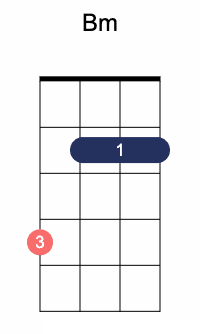
The most notable difference between B Minor and other basic ukulele chords is that the former steps outside of the 3-fret bounds with a B note played at the fourth position on the G string.
The three remaining notes include a D located on the second position of the C string, an F# on the second position of the E string, and a high B note in the second position of the A string.
If you take a look at the diagram above, the finger positioning for this chord almost looks like an inverted power chord. For most players, it’s easier to form a bar with the index finger and accurately pinpoint the root instead of the other way around.
Fortunately, there are more than a few different voicings that you can use to get around this small issue. But first, let’s talk about how to play the basic version of the B Minor Chord.
RELATED: Learn How to Play the B Ukulele Chord
How to Play the Bm Ukulele Chord

VS
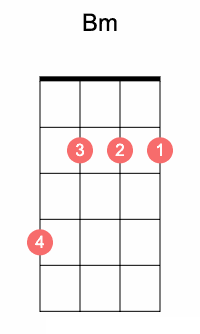
The most common way to play the Bm chord on a ukulele is to form a bar chord over D, F#, and B2 with your index finger before fretting the B1 note with your ring finger. If your ukulele’s frets are ultra-wide, or if your fingers are slim enough, you could also press D, F#, and B2 with your index, middle, and ring finger, and then B1 with your pinky.
The main reason why you would consider the latter approach is to ensure that each tone is properly played with no buzzing. Many players, especially beginners, have a hard time playing bar chords that sound good, failing to apply sufficient pressure on each of the three fret positions.
On the downside, the method of using four fingers to play this chord requires a lot of dexterity and practice. The first method is far simpler when it comes to the practical application of the Bm chord.
Bm Ukulele Chord Voicings and Alternative Finger Positions
The term “voicing” refers to the way notes in a certain chord sound. It’s common practice for seasoned ukulele players (and musicians generally) to rearrange the note positions in chords that are difficult to fret, resulting in a variety of so-called “voicings.”
In other words, it is possible to press different frets (and even play different notes) to produce sounds that are sonically equivalent to the original chord. Without diving too deep into music theory, let me give you a few examples of alternative finger positions for the Bm chord on the uke.
High Pitch Voicing
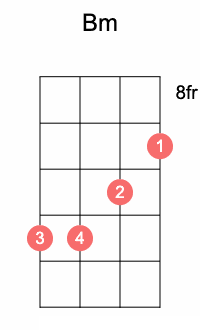
If you’re a solo ukulele player and commonly find yourself on the higher end of the fretboard, this alternative voicing could be easier to pull off than returning to B, D, F#, and B2.
As you can see in the diagram above, the positions of notes are rearranged quite a bit. The F# note is on the G and A strings instead of the C string; the D note is on the E instead of the G string while the note B is on the C string instead of G and A.
Frets are usually a bit slimmer from the 12th position and onward, making it easier to press the high F# on the A string.
Shortened B Minor
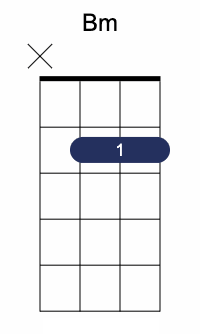
The B on the G string is usually what causes most players trouble when playing the Bm chord, so why not leave it out entirely? Even though this will make the chord lose a bit of its fullness, it’s an ideal shortcut for beginners to focus on learning how to play this chord efficiently.
Once again, either form a bar over the D, F#, and B, or use your index, middle, and ring finger to press the notes on C, E, and, A strings from the 2nd position to play this Bm voicing.
Practice this shorter version for a while, and as soon as you’re confident in your playing accuracy, start adding the lower B with your pinky finger on the fourth position of the G string.
Bm Accompanying Chords
If you’re into jamming or songwriting on your ukulele and are looking for chords that might sound well with Bm, I recommend using the following voicings of E Minor and F# Major chords.
E Minor
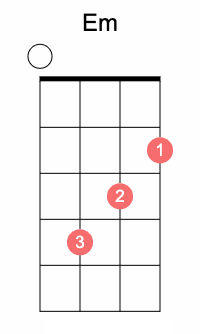
The best way to follow a B Minor is to play a hauntingly beautiful E Minor chord. These chords blend like peanut butter and jelly in virtually all scenarios, especially if you’re playing a song that is supposed to sound as melancholic as possible.
To play E Minor, simply place your fingers as follows:
- A: Index finger on the 2nd fret
- E: Middle finger on the 3rd fret
- C: Ring finger on the 4th fret
- G: None (or leave open)
F# Major
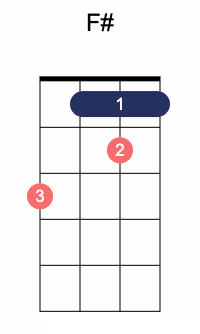
A “happy” chord that somehow manages to sound sad when put between the nostalgic Bm and Em chords. Great news is, that it’s very similar to playing the Bm chord just shifted to the first position. All you need to do is add your middle finger to the E string on the 2nd fret and you have F# major.
To play the F# Major chord, press the following frets:
- A: Index finger forms a bar on the 1st fret.
- E: Index finger (bar)
- C: Index finger (bar)
- G: Ring finger on the 3rd fret
Final Words
The main reason why you should try the simplified versions of the B Minor chord is to understand that you have alternatives. There are no “right” or “wrong” ways to play any ukulele chord, including Bm, so keep these alternate voicings in mind if you’re not making as much progress as you would like.

Jay Searle
Website Founder & WriterJay is a self-professed music nerd and ukulele lover. When not working on the website you’ll find him strumming along to his favorite tunes, spending time with his family, or learning to play the piano.





